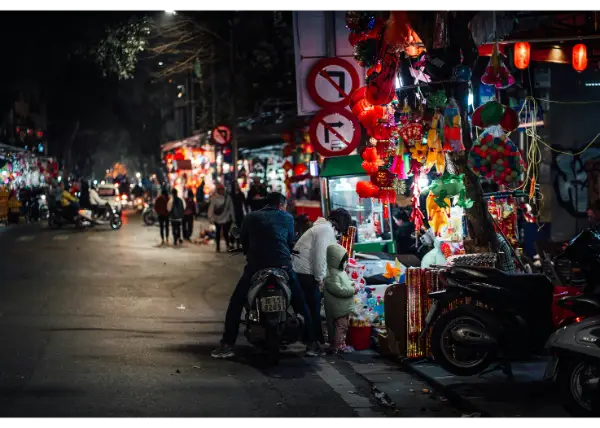A Land of Natural Wonders, Rich Culture, and Rapid Growth

Curious about Vietnam? This Southeast Asian country is famous for its lush landscapes, ancient temples, and vibrant street food scene.
With a blend of tradition and modernity, Vietnam offers something for every traveler and investor, from bustling cities and serene countryside to historical landmarks and a booming economy.
Here’s a detailed guide by Firstchoicereview.com to what makes Vietnam an exciting destination.
Top 3 Benefits of Visiting Vietnam
- Stunning Natural Landscapes
From the emerald waters of Ha Long Bay to the rice terraces of Sapa, Vietnam’s scenery is breathtaking. Whether you love beaches, mountains, or jungles, there’s a landscape waiting to be explored.
Example: Ha Long Bay, a UNESCO World Heritage Site, features thousands of limestone islands, perfect for boat tours, kayaking, and exploring caves. - Rich Cultural Heritage and History
Vietnam has a fascinating history that spans ancient kingdoms, colonial rule, and modern resilience. The country’s temples, pagodas, and cultural festivals reflect its deep-rooted heritage.
Tip: Don’t miss the ancient town of Hoi An, known for its well-preserved architecture and colorful lantern festivals. - Affordable and Flavorful Cuisine
Vietnamese food is renowned for its balance of flavors—from the freshness of herbs to the savory richness of sauces. Plus, Vietnam is budget-friendly, allowing travelers to enjoy world-class food at affordable prices.
Recommendation: Try local street foods like pho (noodle soup) and banh mi (Vietnamese sandwich) for an authentic taste of Vietnam.
Geography and Climate
A long, narrow country bordering China, Laos, and Cambodia, with a coastline along the South China Sea. Its geography includes mountains, deltas, beaches, and forested hills.
Climate Zones:
- Northern Vietnam: Has a subtropical climate with four seasons. Winter (December to February) can be cool, while summer (June to August) is hot and humid.
- Central Vietnam: Experiences warm, sunny weather most of the year, though heavy rains occur from October to December.
- Southern Vietnam: Has a tropical climate with a rainy season from May to October and a dry season from November to April.
Best Time to Visit: November to April is ideal, with cooler, drier weather across the country.
History and Cultural Highlights
Culture is influenced by Buddhism, Confucianism, Taoism, and the legacies of colonialism. It’s a country where tradition and modernity coexist harmoniously.
Cultural Highlights:
- Historic Sites: The ancient capital of Hue is known for its imperial city, tombs, and pagodas.
- Temples and Pagodas: Important religious sites like the Temple of Literature in Hanoi and Thien Mu Pagoda in Hue offer glimpses into Vietnam’s spiritual traditions.
- Festivals: The Tet Festival (Vietnamese Lunar New Year) is the most important celebration, marked by family gatherings, special foods, and traditional customs.
Personal Experience: Many travelers find that exploring Vietnam’s temples and ancient sites gives them a deeper appreciation of the country’s history and spirituality.
Vietnam’s Economy and Key Industries
Vietnam is one of Asia’s fastest-growing economies, driven by manufacturing, agriculture, and an expanding tourism industry.
Key Economic Sectors:
- Manufacturing: Vietnam is a major exporter of electronics, textiles, and footwear, with many global brands producing goods here.
- Agriculture: Known for rice, coffee, and seafood, Vietnam’s agricultural exports are vital to its economy.
- Tourism: Millions visit each year to experience Vietnam’s natural beauty, culture, and cuisine.
Future Growth: Vietnam is attracting foreign investment and focusing on tech innovation, positioning itself as a manufacturing hub in Asia. Efforts to improve infrastructure and education are also boosting its economic potential.
Cuisine: A Symphony of Flavors
Vietnamese cuisine is celebrated for its fresh ingredients, balanced flavors, and healthy dishes. Influenced by French, Chinese, and indigenous cooking styles, Vietnamese food is diverse and satisfying.
Must-Try Dishes:
- Pho: A fragrant noodle soup with beef or chicken, herbs, and rice noodles.
- Banh Mi: A Vietnamese sandwich with meat, vegetables, and herbs in a crispy baguette.
- Bun Cha: Grilled pork served with vermicelli noodles, fresh herbs, and a tangy dipping sauce.
- Goi Cuon (Spring Rolls): Fresh spring rolls filled with shrimp, pork, and vegetables, wrapped in rice paper.
Street Food Tip: Is known for its street food culture. Try local markets and street stalls in cities like Hanoi and Ho Chi Minh City for an affordable and authentic food experience.
Top Travel Destinations in Vietnam
- Hanoi
Vietnam’s capital combines ancient temples, French colonial architecture, and a bustling old quarter. Don’t miss the Ho Chi Minh Mausoleum and Ngoc Son Temple. - Ho Chi Minh City (Saigon)
Known for its vibrant energy, Ho Chi Minh City is a modern metropolis with historical sites like the War Remnants Museum and Cu Chi Tunnels. The city is also famous for its nightlife and street food. - Ha Long Bay
With thousands of limestone islands and caves, Ha Long Bay is ideal for boat cruises and kayaking. Its ethereal beauty makes it one of Vietnam’s most famous destinations. - Hoi An
This ancient town is known for its lantern-lit streets, historic architecture, and tailor shops. Hoi An’s Old Town is a UNESCO World Heritage Site and a must-visit. - Sapa
Nestled in the mountains, Sapa is famous for its rice terraces, ethnic minority villages, and trekking routes. It’s ideal for those who love nature and adventure.
Quick Pros and Cons of Visiting
Pros:
- Affordable travel: Vietnam offers excellent value for food, accommodation, and activities.
- Rich cultural experience: From temples to street food, there’s a unique experience around every corner.
- Friendly locals: Vietnamese people are known for their hospitality and kindness.
Cons:
- Weather can be extreme: The rainy season can affect travel plans in certain areas.
- Traffic in cities: Hanoi and Ho Chi Minh City are known for their busy streets, which can be overwhelming.
Frequently Asked Questions for First-Time Travelers
Is the Philippines safe for tourists?
Yes, the Philippines is generally safe, especially in popular tourist areas. However, it’s always best to stay aware of your surroundings.
What’s the best time to visit?
The ideal travel season is from November to April when the weather is dry and pleasant.
What language is spoken?
Filipino and English are the official languages, and English is widely spoken, especially in urban areas and tourist spots.
What language is spoken?
Filipino and English are the official languages, and English is widely spoken, especially in urban areas and tourist spots.
What currency is used in the Philippines?
The Philippine Peso (PHP) is the official currency. Major cities and tourist destinations accept credit cards and have ATMs available.
What are the must-visit destinations?
Popular spots include Boracay for beaches, Palawan for nature, Cebu for history, Manila for city life, and Banaue Rice Terraces for culture.
- Is Vietnam safe for tourists?
Yes, Vietnam is generally safe for tourists, though it’s advisable to keep an eye on personal belongings in busy areas. - What is the best time to visit?
November to April offers the best weather conditions across the country. - What language is spoken in Vietnam?
Vietnamese is the official language, but English is commonly spoken in tourist areas.
Tip: Learning a few basic Vietnamese phrases can enhance your travel experience and make interactions with locals more enjoyable.
Conclusion: Why Vietnam Should Be on Your Travel List
Vietnam is a country of rich traditions, natural beauty, and exciting opportunities. Whether you’re drawn to the scenic landscapes of Ha Long Bay, the ancient charm of Hoi An, or the bustling energy of Hanoi, has something for everyone.
The combination of affordable travel, flavorful cuisine, and a deep cultural heritage makes Vietnam a destination that captures the hearts of travelers worldwide.
Ready to experience Vietnam? From exploring historic sites to enjoying street food, Vietnam promises an unforgettable journey filled with discoveries and memories.
Source:
- Britannica: – https://www.britannica.com/place/Vietnam
A comprehensive resource for Vietnam’s geography, history, culture, and political structure. - Vietnam National Administration of Tourism – https://vietnamtourism.gov.vn/english/
The official tourism website provides information on destinations, travel tips, cultural insights, and upcoming events. - World Bank: – https://www.worldbank.org/en/country/vietnam
Offers detailed insights into Vietnam’s economy, development, and key sectors.
